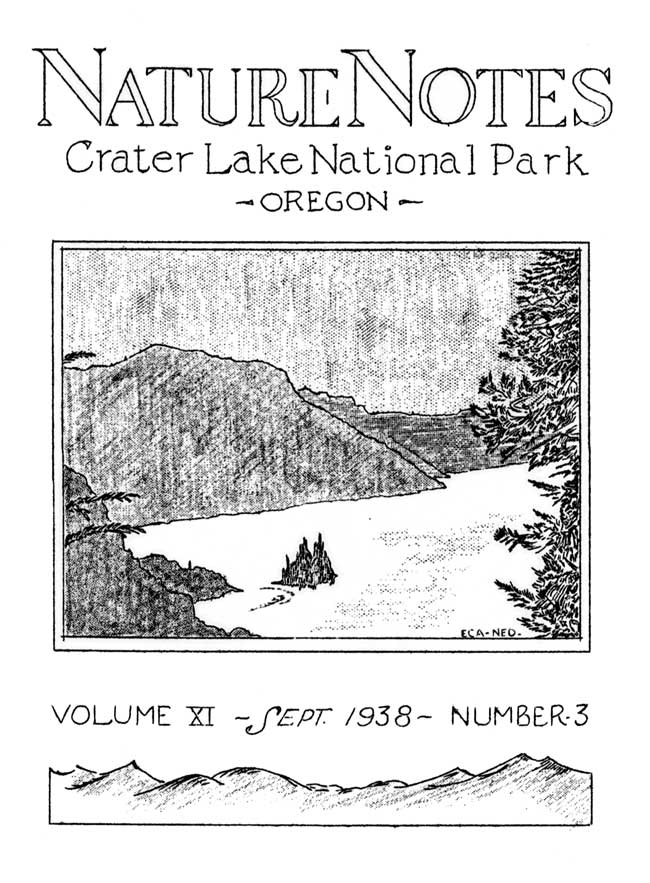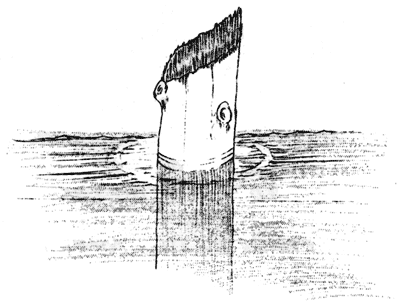
Volume 11 No. 3 – September 1, 1938All material courtesy of the National Park Service. These publications can also be found at http://npshistory.com/Nature Notes is produced by the National Park Service. © 1938. |
Preface
By John E. Doerr, Jr., Editor
Crater Lake National Park
The park includes an area of 250 square miles on the crest of the Cascade Range in southern Oregon. The area was established as a national park in 1902, preserving the unsurpassed scenic beauty of Crater Lake, a deep lake, the clear fresh water of which reflects and refracts unusual hues of blue. Color is only one of the elements of the inspiring beauty of Crater Lake. Its setting is unique. The lake, having an area of 20 square miles, is cupped within the crater of an extinct volcano. Cliffs 500 to 2000 feet high completely surround the lake. The crater walls are partially mantled with hemlock, fir, and pine trees. On the gentle outer slopes of the mountain which one ascends in approaching Crater Lake there are deep canyons, magnificent forests and open meadows supporting a colorful display of mountain wild flowers. Hiking and fishing are popular outdoor sports during the summer months. Skiing is popular in the winter, and the park being accessible throughout the winter months by the west entrance road from Medford and the south entrance road from Klamath Falls.
Oregon Caves National Monument
This national monument, an area of 480 acres, is located in the Siskiyou Mountains in southwestern Oregon. The caves, named “The Marble Halls of Oregon” by Joaquin Miller, are truly marble halls. Underground water penetrating to great depth along fractures in the marble formation has dissolved out an extensive system of chambers. Water dripping from the ceiling and walls has decorated the halls and passageways with fantastic stalactites and stalagmites which stimulate one’s imagination as well as one’s appreciation of the beauties of nature in caverns never touched by sunlight. In the magnificent forest around the cave entrance there are trails along which one gets inspiring views of forest-covered mountains and valleys. Along the trails one can observe many species of trees, mammals, and birds.
Lava Beds National Monument
Located in northeastern California, the monument includes an area of 45,000 acres. As the name suggests, volcanic formations, some of quite recent origin, are of greatest importance. There are hundreds of lava tubes which were once the passageways for streams of molten lava. Volcanic cones rise above the general level of the adjacent country. There are excellent examples of “aa” and “pahoehoe” lava flows. Within the monument there are interesting historical features including battlefields of the Modoc War of 1872-73. There are important ethnological and archaeological features. Petroglyphs on cliffs and pictographs in caves are evidence that the region was inhabited by primitive people long before the coming of the white man.
By Elmer C. Aldrich, Ranger Naturalist, 1938
During the latter part of July or the first part of August the highly vagarious Sierra Crossbill (Loxia curvirostra bendirei) are conspicuous in Crater Lake National Park. They are to be heard or seen in great numbers nearly everywhere within the boundaries. The occurrence of these birds at the rim of Crater Lake seems to be coincident with the production of mature cones of the White-bark Pines and Mountain Hemlocks.
Though they are usually seen in small flocks up to about fifteen in number, occasionally a single individual may be seen flying, giving with each undulation of its finch-like flight a pair of staccato notes (chup-chup). When flying in flocks the notes are given as when flying singly, but seemingly not so loud. Undoubtedly, at this time of the year, there is a desire in the crossbills to flock, and the staccato notes may serve either to attract other individuals to join the flight or serve to keep the already formed flock together. Flocks may be seen to start off without any provocation visible to the observer, continue loosely in an aimless, erratic course, and either fly out of sight or suddenly circle above a group of trees, and then settle as quickly as the flight began. The stay may last several minutes while feeding ensues, or the flock may stop only momentarily and then individuals strike up a chatter consisting of the ordinary notes but given in faster succession. This seems to be the signal for another flight of the same type. When a flock has descended into a tall coniferous tree, the individuals can be seen only with difficulty because the birds take up positions which are usually well within the foliage. Frequently, however, one of the flock may remain perched on the topmost branch and continue giving the notes as though on guard. Usually the others are less noisy while foraging. Though there is little evidence that the crossbills nest in the park, the writer is of the opinion that they nest fairly commonly but are not obvious due to their remaining singly or in pairs, and not giving the staccato flocking note which brings them to the observer’s attention later in the season. On one occasion the writer (August 26) observed a yellowish crossbill high in a tree feeding a young one that was streaked and that could fly excellently.
Description
Sierra Crossbills, if approached cautiously, are confiding and can be observed easily, especially if they are feeding or drinking. One will immediately notice that members of a flock vary greatly in coloration and markings. One has some difficulty in finding two individuals very much alike. The young of the year may look totally gray at a distance but on closer examination they are found to be streaked with dirty white and gray, making them appear similar to the immature and female Cassin’s Purple Finch which are so common in this region. The streaking of the crossbills is finer and more irregular than that of the purple finch which gives the former a more variegated appearance. The adults are more brilliantly colored on the head and rump than the young, and the colors of these parts may be seen as lemon-yellow, greenish-yellow, yellow-green, orange, rose-red and scarlet. Some ornithologists have attributed these variations in color of individuals to differences in age, but this fact is yet to be proven.
In form, the crossbill, about six inches in length, presents a stockier build than that of the purple finch, having a relatively shorter tail that is more deeply forked. The head is relatively larger, probably serving to support the massive, specialized bill structure which certainly is the most distinct feature of the crossbill. The tips of the mandibles do not meet but cross near the ends, not always in the same direction, but seemingly indiscriminately in the different individuals as observed in flocks. Though it is generally believed that the bill structure is advantageous since the crossbill lives on a diet of sees obtained from the cones of conifers, from observations it seems apparent that their ability to grasp small objects with the tips of the bill has some disadvantages. It is this crossing character of the bill in relation to what are apparently peculiar feeding habits that prompted observations recorded in these notes.
Salt-Feeding Habits
During the summer of 1938 Crossbills, Pine Siskins and Cassin’s Purple Finches were seed frequenting cliffs of andesite and pumice. In all instances the birds were seen to fly only to those parts of the cliffs coated with a soft, white to pink powdery crust of calcium salts not more than one-sixteenth of an inch in thickness. Certain parts of the rock exposed in the large road cut on the west side of Watchman Peak and the pumice cliffs exposed along Sand Creek are well supplied with such crusts. These crusted portions of the cliffs were regular forage grounds for the members of the finch family, apparently requiring salts in their diet. The crossbills visited the cliffs more than the other two species mentioned, and were more easily watched. Approaches were made to within twenty feet of the foraging birds their actions being observed for some time. Occasionally the flocks were diluted with one or two Siskins or Purple Finches, but because of their greater wariness comparisons of their salt-gathering habits were not made. Sometimes the crossbills would fly back and forth to the forage cliffs from a convenient perching tree nearby. At other times the flock would remain on the cliffs for the entire stay which would terminate with a flight out of the region. It may be possible, with additional observations, to correlate the differences of feeding habits with the nature of the cliff face and character of the salty crusts. Flights to and from rough cliffs which apparently afford the most suitable perching places occur less frequently. In all types of feeding the process seems to be a slow one with deliberate movements predominating.
On nearly vertical and relatively smooth cliff faces two types of feeding positions were observed. By far the most frequent position assumed was that resembling a woodpecker. The birds would fly directly to the cliff face and with some difficulty gain a foothold with the claws, and with depressed tail sustain a vertical position on or beside a white salt patch. Usually a pause of a few seconds was made prior to feeding and then the slow methodical movements were begun. Since they can pick up nothing with the tips of the bill the procedure was to place the head sidewards to the rock face, open the bill very wide and slowly move the tongue in and out, allowing the side of the tongue to lick off the salty crust. The tongue was distinctly reddish in bright sunlight and seemed unusually large for bird of this size. Such a use of the tongue is probably necessary in order to manipulate certain foods under the handicap of the crossed mandibles. Frequently the birds were seen to loosen the salt crusts by picking at them and follow with the usual licking process.
Another salt-foraging position observed as like that of a nuthatch, that is upside down. This position in all instances was seen to result from a pivot made from the regular woodpecker position. One bird in the nuthatch position was seen to have its lower mandible inserted in a notch in the rock to prevent slipping down head first, while all the time the fleshy tongue was at work.
Further study may indicate how much the location of suitable salt-forage grounds limits the range of this interesting species, and to what extent the physiology of the crossbill makes the feeding of salts imperative.
Wind Currents In Crater Lake
As Revealed By
The Old Man Of The Lake
By Wayne E. Kartchner, Ranger Naturalist and
John E. Doerr, Jr., Park Naturalist
The Old Man of the Lake is the name given to a tall stump of tree which has been floating around in Crater Lake for a number of years. During the period July 1 and September 30 of this year eighty-four observations were made of its location. The record of observations indicates that “The Old Man” travels extensively, and at times with surprising rapidity. The record of its travels, reproduced on the accompanying sketch maps, indicates some interesting facts relative to the wind currents on Crater Lake.
The Old Man of the Lake is mute evidence of a rock slide which occurred on the crater wall years ago, the slide breaking off a tree and carrying down the stump in the roots of which rocks remained wedged. For years the barkless stump has floated in an up-right position. Its top, bleached and splintered, stands four and one half feet out of water. Thirty feet, including the root system, is below water. At water-line the stump, probably hemlock, is two feet three inches in diameter. On one side of the stump and just above water-line there is a clump of moss.
For a number of years The Old Man of the Lake has been observed by visitors at Crater Lake. Not infrequently it has been mistaken for a boat, and occasionally for a white pelican. The earliest accurate date of its existence is 19292. The following quotation taken from William Gladstone Steel’s Crater Lake Scrapbook suggests that “The Old Man” was observed many years before 1929.
“In the early days of Crater Lake, when there was not a nail or sliver of board there, Fred h. Kiser, now a well known scenic photographer, accompanied me to that wonderful place and was infatuated with it. Joaquin Miller was with us and wrote his poem, “The Silent Sea”, on a box in from of his tent. Fred Kiser found a boat and pulled out to search for llao which he saw near the Phantom Ship. It was a great tree, broken squarely off and floating up-right.”
While movements of “The Old Man” have been observed for several years, not date has been recorded relative to its location from day to day. As the result of an inquiry relative to its location from Washington, D. C. in regard to the log floating in Crater Lake, the project of recording “The Old Man’s location was undertaken during the summer of 1938. Observations began on July 1 and were continued until October 1. During that time 84 location records were made. On some days two observations were made. There were a few periods of from two to five days when no locations were recorded, the object not being visible from the launch making the daily trip around the lake, and conditions being unfavorable for observation from the crater rim. There were several periods when the stump was lodged near shore for several days.
The outstanding feature of the travels of “The Old Man”, as shown by the accompanying sketches, is that during July and August and the first half of September it traveled almost entirely within the north half of the lake. This certainly indicates that during that time there was a prevailing southerly wind which was deflected locally by the crater walls to the extent that numerous eddys and cross currents were created, thus accounting for the continuous back and forth movement of the floating stump. It is interesting to note that long the northern shore of Crater Lake there are noticeable wave terraces of gravel and debris. The terraces, not present on the southern shore, are additional evidence of prevailing southerly winds.
During the period of observation “The Old Man” traveled a total minimum of 62.1 miles, the distance between locations being measured in straight lines as indicated on the sketches. The actual distance was no doubt greater than 62.1 miles. The average daily travel was 0.67 of a mile, the maximum distance accomplished was 3.8 miles on August 6 when two observations were made, one early in the morning, the other late in the evening. The days when the greatest movement occurred were days of high wind and waves.
Time will tell how long The Old Man of the Lake can withstand wind and wave, and the battering to which its base is subjected when it approaches shore. Until it does succumb to the elements it will remain as evidence of the changing winds that stir Crater Lake. On the evening of September 30, when the last recorded observation was made, “The Old Man” was riding the waves about a half mile from the south shore, directly below Sinnott Memorial.
Note: From July 1 to September 12 observations of the location of The Old Man of the lake were recorded by Ranger Naturalist Kartchner. During the remainder of September observations were recorded by the Park Naturalist. — Editor
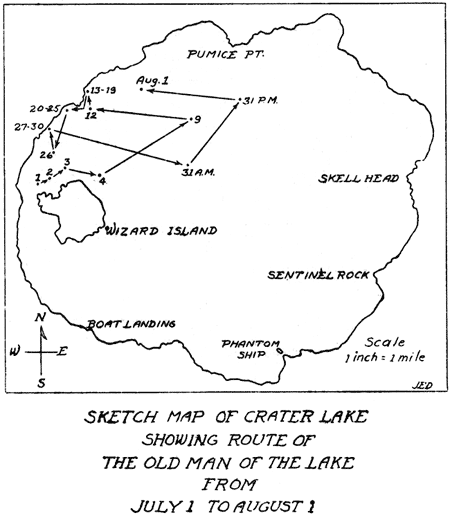
(click on image for an enlargement in a new window)
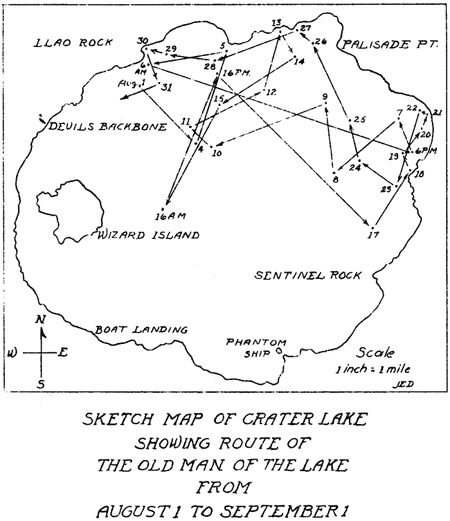
(click on image for an enlargement in a new window)
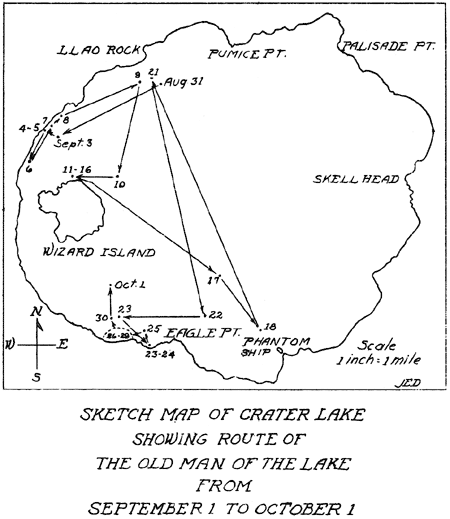
(click on image for an enlargement in a new window)
Salt-Feeding Habits
During the summer of 1938 Crossbills, Pine Siskins and Cassin’s Purple Finches were seed frequenting cliffs of andesite and pumice. In all instances the birds were seen to fly only to those parts of the cliffs coated with a soft, white to pink powdery crust of calcium salts not more than one-sixteenth of an inch in thickness. Certain parts of the rock exposed in the large road cut on the west side of Watchman Peak and the pumice cliffs exposed along Sand Creek are well supplied with such crusts. These crusted portions of the cliffs were regular forage grounds for the members of the finch family, apparently requiring salts in their diet. The crossbills visited the cliffs more than the other two species mentioned, and were more easily watched. Approaches were made to within twenty feet of the foraging birds their actions being observed for some time. Occasionally the flocks were diluted with one or two Siskins or Purple Finches, but because of their greater wariness comparisons of their salt-gathering habits were not made. Sometimes the crossbills would fly back and forth to the forage cliffs from a convenient perching tree nearby. At other times the flock would remain on the cliffs for the entire stay which would terminate with a flight out of the region. It may be possible, with additional observations, to correlate the differences of feeding habits with the nature of the cliff face and character of the salty crusts. Flights to and from rough cliffs which apparently afford the most suitable perching places occur less frequently. In all types of feeding the process seems to be a slow one with deliberate movements predominating.
On nearly vertical and relatively smooth cliff faces two types of feeding positions were observed. By far the most frequent position assumed was that resembling a woodpecker. The birds would fly directly to the cliff face and with some difficulty gain a foothold with the claws, and with depressed tail sustain a vertical position on or beside a white salt patch. Usually a pause of a few seconds was made prior to feeding and then the slow methodical movements were begun. Since they can pick up nothing with the tips of the bill the procedure was to place the head sidewards to the rock face, open the bill very wide and slowly move the tongue in and out, allowing the side of the tongue to lick off the salty crust. The tongue was distinctly reddish in bright sunlight and seemed unusually large for bird of this size. Such a use of the tongue is probably necessary in order to manipulate certain foods under the handicap of the crossed mandibles. Frequently the birds were seen to loosen the salt crusts by picking at them and follow with the usual licking process.
Another salt-foraging position observed as like that of a nuthatch, that is upside down. This position in all instances was seen to result from a pivot made from the regular woodpecker position. One bird in the nuthatch position was seen to have its lower mandible inserted in a notch in the rock to prevent slipping down head first, while all the time the fleshy tongue was at work.
Further study may indicate how much the location of suitable salt-forage grounds limits the range of this interesting species, and to what extent the physiology of the crossbill makes the feeding of salts imperative.
Wind Currents In Crater Lake
As Revealed By
The Old Man Of The Lake
By Wayne E. Kartchner, Ranger Naturalist and
John E. Doerr, Jr., Park Naturalist
The Old Man of the Lake is the name given to a tall stump of tree which has been floating around in Crater Lake for a number of years. During the period July 1 and September 30 of this year eighty-four observations were made of its location. The record of observations indicates that “The Old Man” travels extensively, and at times with surprising rapidity. The record of its travels, reproduced on the accompanying sketch maps, indicates some interesting facts relative to the wind currents on Crater Lake.
The Old Man of the Lake is mute evidence of a rock slide which occurred on the crater wall years ago, the slide breaking off a tree and carrying down the stump in the roots of which rocks remained wedged. For years the barkless stump has floated in an up-right position. Its top, bleached and splintered, stands four and one half feet out of water. Thirty feet, including the root system, is below water. At water-line the stump, probably hemlock, is two feet three inches in diameter. On one side of the stump and just above water-line there is a clump of moss.
For a number of years The Old Man of the Lake has been observed by visitors at Crater Lake. Not infrequently it has been mistaken for a boat, and occasionally for a white pelican. The earliest accurate date of its existence is 19292. The following quotation taken from William Gladstone Steel’s Crater Lake Scrapbook suggests that “The Old Man” was observed many years before 1929.
“In the early days of Crater Lake, when there was not a nail or sliver of board there, Fred h. Kiser, now a well known scenic photographer, accompanied me to that wonderful place and was infatuated with it. Joaquin Miller was with us and wrote his poem, “The Silent Sea”, on a box in from of his tent. Fred Kiser found a boat and pulled out to search for llao which he saw near the Phantom Ship. It was a great tree, broken squarely off and floating up-right.”
While movements of “The Old Man” have been observed for several years, not date has been recorded relative to its location from day to day. As the result of an inquiry relative to its location from Washington, D. C. in regard to the log floating in Crater Lake, the project of recording “The Old Man’s location was undertaken during the summer of 1938. Observations began on July 1 and were continued until October 1. During that time 84 location records were made. On some days two observations were made. There were a few periods of from two to five days when no locations were recorded, the object not being visible from the launch making the daily trip around the lake, and conditions being unfavorable for observation from the crater rim. There were several periods when the stump was lodged near shore for several days.
The outstanding feature of the travels of “The Old Man”, as shown by the accompanying sketches, is that during July and August and the first half of September it traveled almost entirely within the north half of the lake. This certainly indicates that during that time there was a prevailing southerly wind which was deflected locally by the crater walls to the extent that numerous eddys and cross currents were created, thus accounting for the continuous back and forth movement of the floating stump. It is interesting to note that long the northern shore of Crater Lake there are noticeable wave terraces of gravel and debris. The terraces, not present on the southern shore, are additional evidence of prevailing southerly winds.
During the period of observation “The Old Man” traveled a total minimum of 62.1 miles, the distance between locations being measured in straight lines as indicated on the sketches. The actual distance was no doubt greater than 62.1 miles. The average daily travel was 0.67 of a mile, the maximum distance accomplished was 3.8 miles on August 6 when two observations were made, one early in the morning, the other late in the evening. The days when the greatest movement occurred were days of high wind and waves.
Time will tell how long The Old Man of the Lake can withstand wind and wave, and the battering to which its base is subjected when it approaches shore. Until it does succumb to the elements it will remain as evidence of the changing winds that stir Crater Lake. On the evening of September 30, when the last recorded observation was made, “The Old Man” was riding the waves about a half mile from the south shore, directly below Sinnott Memorial.
Note: From July 1 to September 12 observations of the location of The Old Man of the lake were recorded by Ranger Naturalist Kartchner. During the remainder of September observations were recorded by the Park Naturalist. — Editor

(click on image for an enlargement in a new window)

(click on image for an enlargement in a new window)

(click on image for an enlargement in a new window)
Editor’s Note Regarding Volume XII Of Nature Notes
By John E. Doerr, Jr., Editor
This number of Crater Lake National Park Nature Notes completes Volume XI. Volume XII will begin with the July 1939 issue.
Web Edition Note: With the advent of World War II, Nature Notes was suspended until 1946.
Other pages in this section

